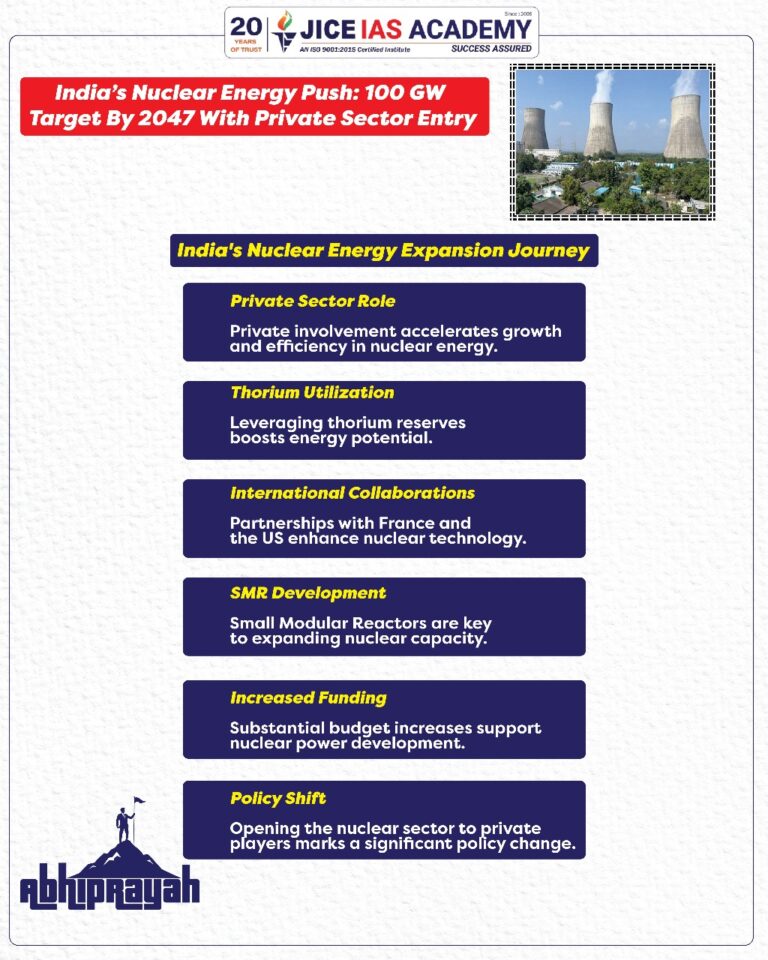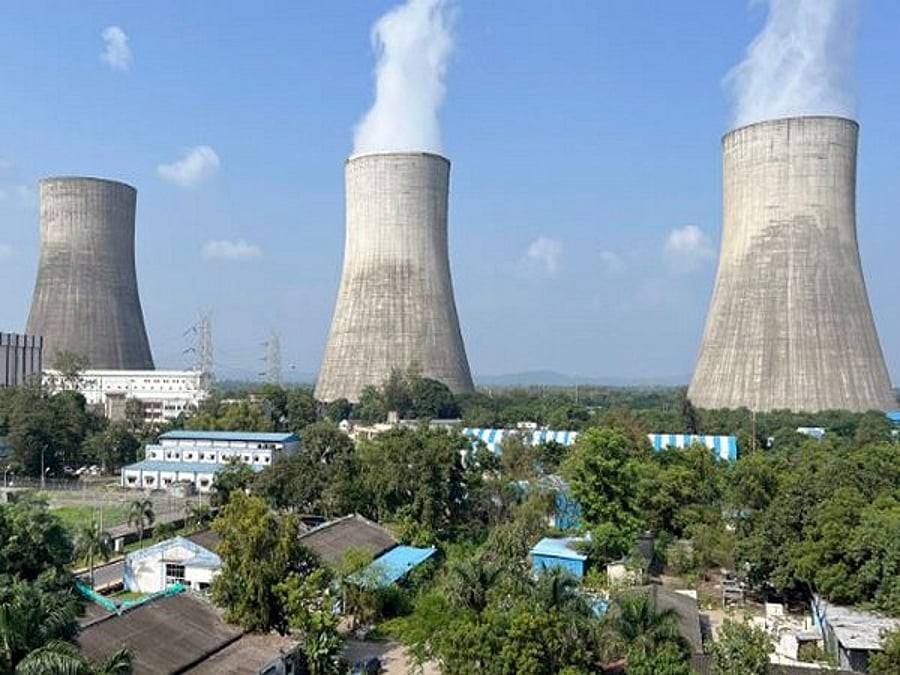UPSC CURRENT AFFAIRS – 28th March 2025
India’s Nuclear Energy Push: 100 GW Target By 2047 With Private Sector Entry

Why in News?
- India has unveiled an ambitious plan to generate 100 GW (gigawatts) of nuclear energy by 2047, signaling a significant shift in its energy strategy.
- A key aspect of this initiative is the decision to open the nuclear sector to private players, a move that was previously unprecedented.
Government Commitment and Policy Initiatives
Union Minister of State for Science and Technology, Dr. Jitendra Singh, highlighted the strategic importance of nuclear mission in the Rajya Sabha.
- He emphasized that nuclear energy is projected to contribute 10% of India’s total energy needs by 2047.
- To support this goal, the government has significantly increased budgetary allocations for nuclear power, with a 170% rise in funding for the Department of Atomic Energy since 2014.
- The 2024-25 budget allocated ₹20,000 crore for the indigenous development of at least five Bharat Small Modular Reactors (SMRs).
Role of Small Modular Reactors (SMRs)
A crucial component of India’s nuclear energy expansion is the development of Small Modular Reactors (SMRs) with capacities ranging from 16 MW to 300 MW. These reactors offer several advantages, including:
- Suitability for remote and industrial areas
- Reduced construction time and cost
- Enhanced safety features compared to conventional reactors
- Lower environmental footprint
By integrating SMRs into India’s energy infrastructure, the government aims to provide reliable and clean electricity to underserved regions while making significant strides toward the country’s net-zero carbon emissions target by 2070.
International Collaborations and Indigenous Development
India is strengthening its nuclear capabilities through strategic collaborations with countries like France and the United States. These partnerships aim to advance nuclear technology while ensuring a strong focus on indigenous research and development. The National Research Foundation, which receives 60-70% of its funding from non-government sources, is expected to play a pivotal role in accelerating nuclear research and innovation in the country.
Thorium Utilization and Revitalization of Projects
India holds 21% of the world’s thorium reserves, a resource that could significantly boost the country’s long-term nuclear energy potential. The government is actively working on:
- Expediting projects like the Bhavini reactor and Kudankulam nuclear plant
- Reviving stalled nuclear energy initiatives
- Promoting advanced research on thorium-based reactors
These efforts reflect India’s commitment to enhancing energy security while leveraging indigenous resources for sustainable power generation.
Private Sector Participation: A Paradigm Shift
The decision to allow private sector involvement in nuclear energy marks a major departure from past policies. Historically, India’s nuclear program was tightly controlled by the government due to security and regulatory concerns. The inclusion of private players is expected to:
- Accelerate technological advancements
- Attract investments in nuclear infrastructure
- Foster competition and efficiency in the sector
This transformation aligns with global trends where private enterprises contribute significantly to nuclear energy development.
Conclusion
India’s nuclear energy mission is set to play a transformative role in ensuring a stable and sustainable power supply for the future. With strong government backing, increased funding, strategic international collaborations, and private sector participation, the country is poised to achieve its 100 GW nuclear energy target by 2047. This initiative not only reinforces India’s position as a leader in clean energy solutions but also addresses the growing electricity demand in an environmentally responsible manner.

Dragon-Elephant duet: Xi Jinping’s congratulatory message to President Murmu on 75th anniversary of India-China ties
UPSC CURRENT AFFAIRS – 04th April 2025 Home / Dragon-Elephant duet: Xi Jinping’s congratulatory message to President Murmu on 75th

Hungary welcomes Netanyahu and announces its quitting top war crimes court
UPSC CURRENT AFFAIRS – 04th April 2025 Home / Hungary welcomes Netanyahu and announces its quitting top war crimes court

How Smoot-Hawley Tariff Act deepened the Great Depression
UPSC CURRENT AFFAIRS – 04th April 2025 Home / How Smoot-Hawley Tariff Act deepened the Great Depression Why in News?

India’s exports to US hit with 27% tariff, Asian rivals face higher tariffs; US markets in turmoil
UPSC CURRENT AFFAIRS – 04th April 2025 Home / India’s exports to US hit with 27% tariff, Asian rivals face

Lok Sabha passes Aircraft Objects and Coastal Shipping Bills
UPSC CURRENT AFFAIRS – 04th April 2025 Home / Lok Sabha passes Aircraft Objects and Coastal Shipping Bills Why in

Instant injustice
UPSC CURRENT AFFAIRS – 04th April 2025 Home / Instant injustice Why in News? The Supreme Court of India has

XV-Finance Commission Grants to Boost Rural Development
UPSC CURRENT AFFAIRS – 04th April 2025 Home / XV-Finance Commission Grants to Boost Rural Development Why in News? The

India, Nepal ink 10 MoUs worth Nepalese Rs.625 million for community development projects
UPSC CURRENT AFFAIRS – 03rd April 2025 Home / India, Nepal ink 10 MoUs worth Nepalese Rs.625 million for community


